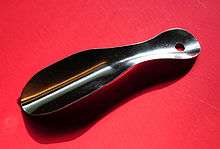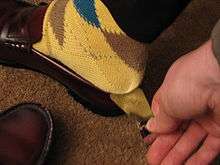Shoehorn


A shoehorn or shoe horn (sometimes called a shoespooner or shoe tongue) is a tool that lets the user put on a shoe more easily. It does so by keeping the shoe open and by providing a smooth surface for the foot and the heel to move, without crushing the shoe's counter (the vertical portion of the shoe that wraps around the back of the foot), in this way acting as a first class lever. Originally, shoehorns were made from animal horn,[1] or hooves, and some made from bulls' hooves are still available for purchase. Today plastic, metal and wood are most often used. They were also made of glass and even paper. Expensive shoehorns were made from ivory, silver, shell, or bone.
There are various sizes of shoehorns, though the basic shape varies little except for the length of the handle. Long handled shoe horns, for example, are necessary for longer boots, and also used to reduce bending and straining by persons lacking joint mobility (e.g., older persons), while shoe horns with sturdy handles are useful for putting on boots or heavy iron shoes.
History
Shoehorns appear to have originated in the late Middle Ages or Renaissance; in English a "schoying horne" is mentioned in the 15th century, though the French word chausse-pied is only found during the last half of the 16th century.[2] Elizabeth I of England bought 18 shoe horns from her shoemaker Garrett Johnson between 1563 and 1566, then in 1567 ordered four more in steel from the blacksmiths Gilbert Polson and Richard Jeffrey, and then needed no more until 1586. Presumably these were used by many people in her household.[3]
A group of more than 20 known English shoe horns are all signed and dated,[4] to between 1593 and 1613,[5] and made by Robert Mindum. All also are inscribed with the names of their owners; These include both men and women, including "JANE HIS WIFE" in 1612.[6] The inscription on one is typical: "THIS IS AMBRES BVCKELLS SHOING HORNE MADE BY ROBART MINDVM ANNO DOMINI 1598". There is also other engraved decoration on all, including heraldic medallions, geometric designs and flowers, covering most of the surfaces, in a style characteristic of later scrimshaw. Their shape is very similar to modern examples, and the longest is 11 inches long; five are turned back at the narrow end in a kind of hook. Several have holes pierced in them, presumably for a cord or leather thong used for pulling them out of the shoe or hanging them up. One owner ("Hamlet Radesdale", 1593) is described as a citizen of London who is a cooper; none of the owners seem to be recorded otherwise. Joan Evans suggested, given the nature of the inscriptions, that Robert Mindum made them as a hobby and gave them to his friends. A powder horn similarly inscribed and decorated by him also survives.[7] The British Museum also has a similar inscribed and decorated horn by another maker.[8][9]
Turn of phrase
"Shoehorning" has come to mean, mostly in American English, the act of coercing or pressuring an individual into a situation which does not leave enough room, either literally or figuratively. Shoehorning in a conversational context means to force someone to take one of a limited number of positions, neither of which may adequately express what the individual wants to say (a "For me or against me"-scenario). Shoehorning in a more literal sense can express itself as pushing a number of individuals into an overfilled enclosure of space, such as a theater or a bus ("the usher shoehorned us into the back of the crowded theater").
Shoehorning can also refer to an unnatural-seeming inclusion of something for reasons which may range anywhere from demographic-pleasing or political correctness (for example, a token character in a television show or film). In this context, Shoehorning can also refer to including or forcing characters into a plot who have little-to-no reason to be there except for appeal or marquee value.
It can also refer to fitting something where it does not easily fit. The shortened expression honking (as in honking around town) derives from this term, referring to inserting one's self into a place or situation where one does not easily fit or is not welcome.
See also
Notes
- ↑ Evans, 282
- ↑ Costume historian; Evans, 282
- ↑ Victoria and Albert Museum; Costume Historian Archived May 30, 2015, at the Wayback Machine.
- ↑ Catalogue; Evans has only seven or so - her wording is not wholly clear as to whether the five in the Drane collection and those in the Evans collection overlap. See also the list of names near the end.
- ↑ 1612 per Evans, 282; 1613 per Robinson; the Victoria and Albert Museum says 1623, a typographic error confirmed in private correspondence with the MoL dated 4 June 2015. Archived February 11, 2016, at the Wayback Machine.
- ↑ Catalogue, 1612
- ↑ Evans, 282-283
- ↑ British Museum; the example Evans (p. 282) thought was in the British Museum but "inaccessible" does not seem to appear in the current online database of their collections.
- ↑ Robinson suggests Evans may be referring to the 18th century shoehorn by Thomas Genn. British Museum accession number, 1889,0930.5
References
- Evans, Joan "Shoe-Horns and a Powder Flask by Robert Mindum", The Burlington Magazine for Connoisseurs, Vol. 85, No. 500 (Nov., 1944), pp. 282–284, JSTOR
- Robinson, W., "Catalogue", Online catalogue of 23 (as at 25 October 2015) Mindum examples with references etc., links to images. Organized by date of horn.
- "Costume Historian", Shoehorns by Robert Mindum (active 1593-1612), Costume Historian blog, with the best photos and further links.
| Wikimedia Commons has media related to Shoehorns. |
| Look up shoehorn in Wiktionary, the free dictionary. |
